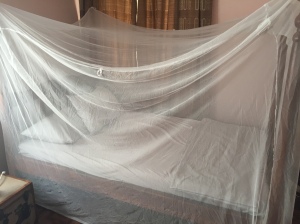My brush with the ‘winged scourge’
by Lorien E. Menhennett
“Shit, do I have malaria?”
That was one of my first thoughts upon returning to the United States from Uganda in late July. I remember thinking that as I was waiting in the customs line at JFK airport in New York City. I’d spent my 12-hour connecting flight from Doha, Qatar, huddled under a thin fleece blanket, shivering, my head and whole body aching. My stomach hurt. I had diarrhea. Potential signs of malaria, I knew.
This was reinforced in our parasitology presentation yesterday, the lecturer saying:
Fever + travel = malaria … until proven otherwise.
While in Uganda, I had spent every night under a mosquito net. I’d religiously taken my Malarone (malaria prophylaxis) as directed. But … my mosquito repellant application had been less than diligent. The bugs weren’t really about during the day, and I was already applying a sticky layer of sunscreen. So I decided to spray myself only in the evening. Problem was, I’d be sitting out on the back porch, drinking Ugandan beer and talking with my friends, and completely forget about the DEET. So a number of mosquitoes got lucky with me. It seemed like even when I applied the spray though, it didn’t make much of a difference. But either way, I had something to fuel my paranoia. And boy, are medical school students good at being paranoid about their health.
Thankfully, I didn’t have malaria — it was probably a stomach virus. Several people I’d been traveling with got something similar. But it was scary. I plan on returning to Uganda for future research, and I certainly will be more careful with the bugs next time. Just in case. No reason to tempt fate.
I’ve always thought of malaria as mainly a travel-related illness. And these days, it is. Interestingly though, I learned in our lecture about how much of the United States was affected by malaria even into the 1940s in several Southeastern states. This was such a big deal that the U.S. government worked with Walt Disney studios to bring back the Seven Dwarves in 1943 to teach people how to knock out mosquitoes, the vectors that transmit malaria. The short film was called “The Winged Scourge,” and I found it on YouTube after hearing it briefly mentioned in our lecture. I couldn’t resist sharing the video (see the top of the page). It’s just under 10 minutes, and it’s hilarious. You’ve got the booming, ominous voice warning you of the winged villain. And then you’ve got the beloved dwarves doing their best to exterminate the critters, and of course getting into mischief along the way.
Some of the advice still holds, like eliminating standing water to get rid of places for mosquitoes to lay their eggs. Though I’d guess there are other methods to try before you lay down an oil slick on ponds to asphyxiate the larvae swimming below. Not too good for the rest of the environment.
It’s a piece of history — of public health history, and of cartoon history. As a socially conscious future physician who was raised on Disney movies, what more could you ask?
Note: If you’re curious about the history of malaria eradication in the United States, here is an interesting (and brief) explanation from the CDC.

Enjoyed the slice of history of Disney and public health! I think you need to forward this to the CDC folks that are working with Zika eradication! Could use the same cartoon with a few tweaks–like you said, pouring oil on ponds may not be the best for the environment and recycling the cans might be a better way to get rid of the mosquito breeding containers rather than burying them! 🙂
LikeLike
Ha. Yes! I’m sure the Seven Dwarves would be great at helping eradicate Zika.
LikeLike